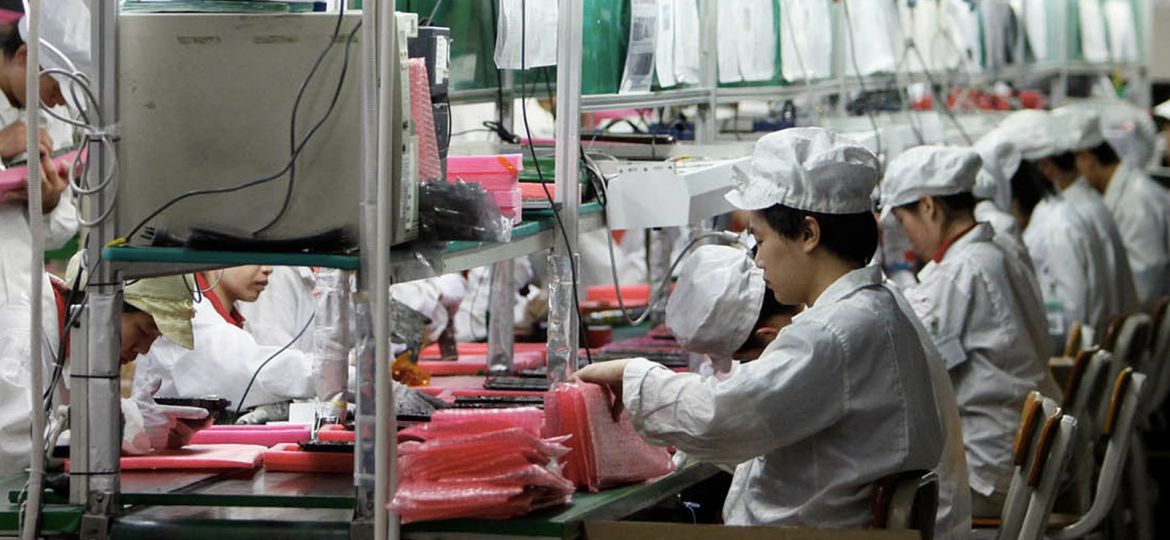
WHY THIS MATTERS IN BRIEF
- Foxconn is one of the world’s largest employers, and its pursuit of 100% automation at all of its factories will put millions out of work and give China a headache
We’re hearing a lot recently about how most of our jobs are going to be automated away by robots and intelligent machines, and new Universal Basic Income schemes, that aim to soften the impact, now Foxconn, the Taiwanese manufacturing giant behind Apple’s iPhone and many other major electronics devices, have announced they are going to automate away all of their human employees – all 1.2 million of them – in order to improve efficiency, safety and reduce costs.
Dai Jia-peng, the general manager of Foxconn’s automation committee, says the company has a three phase plan in place to fully automate its Chinese factories using software and in house robotics units, known as Foxbots.
The first phase of Foxconn’s automation plans involve replacing the work that is either dangerous or involves repetitious labor humans are unwilling to do. The second phase involves improving efficiency by streamlining production lines to reduce the number of excess robots in use, and the third and final phase involves automating entire factories, “with only a minimal number of workers assigned for production, logistics, testing, and inspection processes,” according to Jia-peng. And then one day, in the not too distant future, these workers will also be replaced, for example with machine vision systems that will be capable of carrying out the inspections, and with robo logistics systems.
The slow and steady march of manufacturing automation has been in place at Foxconn for years. The company said last year that it had set a benchmark of 30 percent automation at its Chinese factories by 2020.
The company now produces around 10,000 Foxbots a year all of which can be used to replace human labor, and last March the company said it had managed to automate away 60,000 jobs at just one of its factories.
Over the long term, robots are cheaper than human labor but the initial investment can be expensive – it’s also complicated, expensive, and time consuming to program robots to perform multiple tasks, or to reprogram them to perform new ones and that’s one of the big reasons why thus far humans have been far more economical.
To stay competitive though, Foxconn believes it has to transition to full automation, and as for the problem of re-programming robots? Well, those problems and costs are going away as robots become more adept at teaching other robots new tasks, using the equivalent of a “hive” mind.
The Chinese government though could complicate Foxconn’s ambitions. They’ve incentivised and prioritised human employment in the country, and in areas like Chengdu, Shenzhen, and Zhengzhou, local governments have paid out billions of dollars in incentives, energy contracts, and public infrastructure to Foxconn to allow the company to expand. However, this too will become less of a problem as the company starts moving and expanding operations abroad to countries such as India, and now, under Trump, the US.
As of last year, Foxconn employed over 1.2 million people, making it one of the world’s largest employers and more than a million of those workers live in China, often at elaborate, university like campuses that house and feed hundreds of thousands of employees.
In an in-depth report published yesterday, The New York Times detailed these government incentives for Foxconn’s Zhengzhou factory, its largest and most capable plant that produces 500,000 iPhones a day and is known locally as “iPhone City.” According to Foxconn’s Jia-peng, the Zhengzhou factory has some production lines already at the second phase of automation and it’s on track to become fully automated in just a few years’ time. So it may not be long before one of China’s largest employers will be forced to grapple with its automation ambitions and the benefits it receives to transform rural parts of the country into industrial powerhouses.
There is, however, a side effect to automation that would specifically benefit a company like Foxconn. The manufacturer has been plagued by its sometimes abysmal worker conditions and a high rate of employee suicide. So much so in fact that Foxconn had to install suicide netting at factories throughout China and take measures to protect itself against employee litigation. By replacing humans with robots, Foxconn would relieve itself of any issues stemming from its treatment of workers without having to actually improve living and working conditions or increase wages. But in doing so, it will ultimately end up putting hundreds of thousands, if not millions, of people out of work, and as far as we humans go, when we look at it like that it’s like curing a broken ankle by sawing off your leg.
However, if you think that Foxconn will end up with just two people on its payroll – the CEO and CFO – then think again, they can be automated too…
















